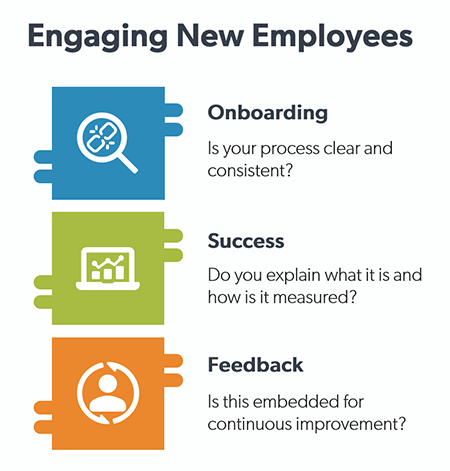Retention in manufacturing is a complex but essential aspect of an organization, and manufacturers that struggle with it can miss out on benefits that come from keeping long-term skilled, efficient employees.
Elizabeth Aldana, Service Line Leader/Senior Consultant for Operational Excellence from WMEP Manufacturing Solutions (WMEP), gave us actionable advice for all manufacturers in our podcast episode, “Improving Employee Retention in Manufacturing.” We’ve outlined the key components to start strengthening your employee retention efforts and create the conditions that help reduce employee turnover.
From employee engagement to performance management, here are four areas of focus for retaining employees in a competitive job market.
1. Improve Your Employee Onboarding Process
 First impressions matter. If your onboarding process is clunky and confusing, you lose a great opportunity to engage your new employee from the very beginning. A 2021 Gallup poll found that only 12% of employees think that their company offers a good onboarding experience, so it’s well worth considering how to improve yours.
First impressions matter. If your onboarding process is clunky and confusing, you lose a great opportunity to engage your new employee from the very beginning. A 2021 Gallup poll found that only 12% of employees think that their company offers a good onboarding experience, so it’s well worth considering how to improve yours.
To make the onboarding process more effective, start by creating a clear and consistent process, which keeps everyone on the same page and lets them know what to expect. Second, you need to define what success looks like and have a way to measure it. For example, if you’re looking for a targeted production rate, how can this be tracked and shared with your new employees so they can see their progress? Finally, a best practice is to collect feedback and build in opportunities for check-ins so that you can continuously improve your process.
Whether your human resources department or the hiring manager leads onboarding, do your best to make things feel personalized. You can’t avoid the administrative side, of course, but a personal touch goes a long way toward fostering employee engagement.
2. Keep Your Employees Engaged
When we talk about employee engagement, we’re talking about their understanding of your organization’s purpose — as well as their role in helping you fulfill it. Employees who feel “plugged in” are much better attuned to the big picture, which, in turn, creates a strong organization from top to bottom.
This is easier said than done in many cases, as problems with engagement are often part of a self-perpetuating cycle. If your team is constantly putting out fires, there’s never any time to develop or implement new ideas. Eventually, people stop trying to come up with ideas in the first place.
If you’re not careful, a lack of employee engagement can even show up in your KPIs (Key Performance Indicators). Customer support is a good example, where a lag in response times or satisfaction scores might indicate an underlying issue.
Feedback is essential to sustaining an engaged workforce, and you can collect it over long intervals (like an annual employee survey) and on a routine basis (like daily huddles). However, if you’re going to collect feedback, you have to be prepared to act on it.
3. Set Clear Employee Performance Expectations
One of the best things you can do for your team is to give them a clear target. From there, each team member can break down what they need to do on a daily basis and understand how their contributions relate to the overall team’s success.
Rewards and incentives can play a big role here. Celebrating success is important for any organization, and that can take many different forms, whether it’s a bonus, profit-sharing, or even a gift card. If you know your team well, you can get creative about what type of reward will motivate them the best.
With clear and transparent expectations and team-tailored rewards, you’ll have both intrinsic and extrinsic bases covered. And if you do hit your target, you can set a new one that is more challenging — just be sure that it is still reasonable.
4. Develop Your Employees’ Skill Sets
Development and retention are closely linked. If employees don’t feel challenged or they don’t feel like they’re advancing, it’s only natural they might look elsewhere to meet those needs.
Be sure to keep open a two-way street so that you can check in with your employees — and vice versa — about their personal and professional development. Does your employee want to upskill and move up the ladder? Do they want to shift horizontally? You can’t know without an ongoing dialogue, and from there (assuming the change is feasible), your training program can take over.
Employee development is smart in terms of both retention and redeployment. The modern manufacturing team needs to respond to market conditions, and a well-rounded team helps organizations adapt to all of the twists and turns that lie ahead in the future.
Final Thoughts on Employee Retention
With such a competitive job market, manufacturing organizations need to do everything they can to retain top talent. This is by no means simple, however, and improving retention can be complex and involve investment in automation or in other areas of your company.





